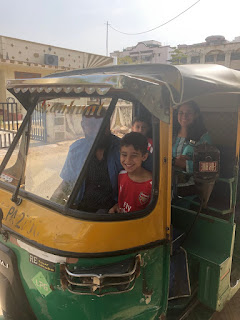Indus International Community School
Today, I visited with my mentor teacher the community school. It was so fascinating.
 |
| This is my mentor teacher at Indus. So nice of her to spend the morning with me to visit the Community School |
First, she taught me that the Right of Children to Free and Compulsory Education Act or Right to Education Act (RTE) is an Act of the Parliament of India enacted on 4 August 2009, which describes the modalities of the importance of free and compulsory education for children between the age of 6 to 14 years in India under Article 21A of the Indian Constitution. Section 12 (1) (c) of the Right of Children to Free and Compulsory Education Act 2009 (the Act) makes it compulsory for every private unaided school to admit at least 25% of its entry level class from children belonging to weaker and disadvantaged groups.
The Indus International School in Bangalore decided to open a community school along side the International School, choosing to accomplish the mandatory 25% (their way ends up being a lot larger) a bit differently than the entire country. Here is their history, ethos, philosophy, vision and mission:
History
Welcome to Indus International Community School which is an equal opportunity school as it provides the same learning facilities to underprivileged children that privileged children receive. The school started its operations on June 21st 2010. This school caters to the education for underprivileged children from Grade 1 to 10.
Our Ethos
- Leadership- the ability to lead oneself first, then others
- Proficiency in English
- Strong community orientation
- Curriculum with emphasis on technology
Our Philosophy
- Holistic development of the child
- Differentiated instruction in classrooms- through individualised
- and collaborative learning
Vision
“To prepare 21st century citizens possessing a strong sense of community, with a Global perspective”
Mission
“To adopt an integrated approach to learning with emphasis on empowering students through Leadership competencies, Proficiency in English, and the power of Technology”
I went on a guided tour by the above student leaders and here is what I learned:
IICS follows a curriculum similar to the IB PYP curriculum from 1st to 5th grade and the Karnataka State Board from 6th to 10th. The curriculum places emphasis on English, Technology, and Leadership Skills. It also helps develop vocational skills in areas such as Computer-Aided Design (CAD); Animation & Graphics; Filmmaking, Photography, etc.
Apart from the learning at school, IICS has Remote Learning Centers (RLCs) in village clusters to support children with their homework, and to provide functional literacy-coaching to parents. In addition to team sports that are fairly common, IICS also provides opportunities for international sports like equestrian, golf, swimming and karate. With rigorous coaching in target sports, balanced with strong academics, the school creates a platform for holistic education.
I asked my mentor teacher why they chose this schema for the 25% requirement through the RTE Act. Her response was that it is for economic reasons. Being amongst all the international students and trying to live up to their standards of an iPhone, laptop, etc., impacted the students social and emotional psyche which resulted in poor academics. I listened, but questioned it in the back of my head. Then on our drive down to Mysore, I was telling Gam about my tour today and she made a very good analogy. She said "isn't the same thing as what kids say about Newton South?" And then a light bulb went off. When our students visit Newton South, they are in awe of all the resources such as a music room, an indoor pool, cooking class, etc., but most of them always say that they prefer New Mission. Why is that? Is it because their social and emotional needs are met or is it a fear of being amongst people that are different from them? That is a whole other project and research question!
 |
| Me, the principal of the community school, and my mentor teacher |







Wow! The Indian education system has improved so much in last 20 years.
ReplyDelete